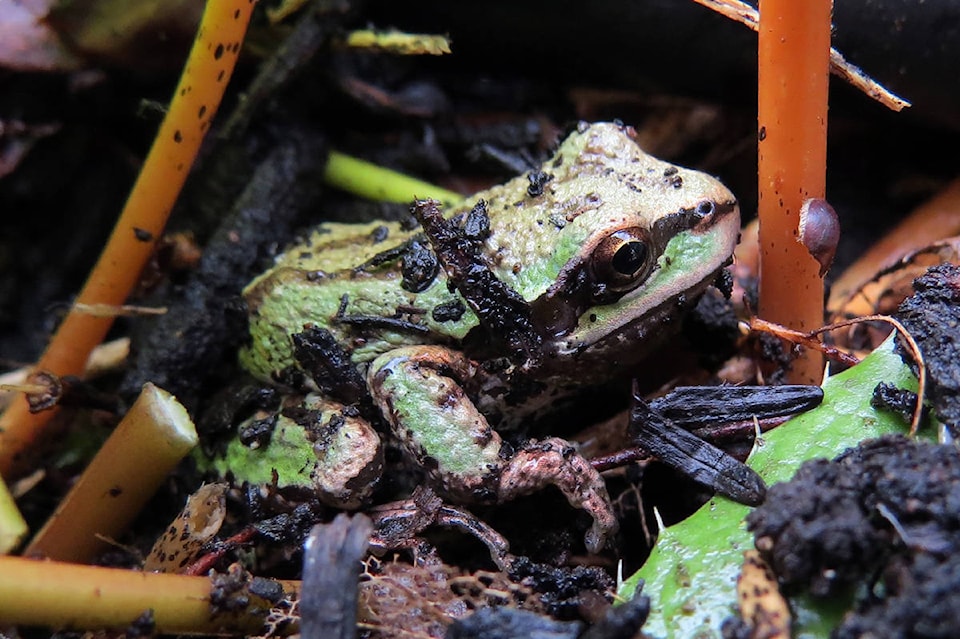Leslie Cox
Special to The Record
So exciting! I recently spotted a very large yellow-faced bumblebee in John’s ‘First Frost’ hellebore. Went running for my camera, and thankfully, the bee was so engrossed in collecting nectar, it was still on the same plant on my return. (Just in case, I had “ordered” John to keep an eye on the bee.)
Got my photos but it would have been nice if I could have somehow gotten a measurement of its size. Not to happen though as the bee was quite skittish, flying off whenever I pushed the camera lens too close. So, best guess…judging by the bee’s positioning in the hellebore flower…it was roughly 15 – 20 mm (0.6 – 0.75 in) long.
I truly suspected this yellow-faced bumblebee, (Bombus vosnesenskii) to be a queen because of its size. This was confirmed when I looked at the photos and could see the tell-tale little bump at the end of its abdomen…an indication the bumblebee was a female. (Males have no tiny bump.)
This queen would have over-wintered in our garden, or nearby, and has likely already established its underground nest. First order of business would be to feed herself, and then look for a suitable male with which to mate.
In bumblebees, the queen looks after the first brood of young, feeding and caring for them. Once these workers have fledged, the queen will switch her focus to egg laying, although towards the end of the season as the worker population declines, the queen will again emerge from the nest and assist with foraging.
While we are on the subject of insects, I would hope all gardeners have their eyes peeled for any irregularities in the garden as they go about their spring chores.
Definitely, we have more cottony scale on our camellia shrub again this year. Comes from not spraying the plant with horticultural oil last year. This scale is not easily spotted as they hide on the underside of the leaves. First clue they have established themselves are the ugly black splotches on the upper side of some leaves.
This black is a sticky fungus which develops on the honeydew excreted by the adult scales. The same type of fungus develops on aphid excrement too. You will see it on your rose leaves, honeysuckle, elderberry, and pretty much on any other plants where aphids congregate.
Wish I could find the culprit that is chewing large sections out of my Panda Face wild ginger, Asarum maximum. I suspect a young slug, but it remains well hidden from view. Two years ago I found a tree frog hiding in the ginger and caught him focussed on a tiny baby slug. (Frogs do eat slugs)
The azaleas are starting to show good leaf bud growth – a reminder I should hang some sticky traps. Apparently, yellow sticky traps have proven to be a decently reliable method to control azalea sawfly adults.
I wrote about this pest last year when we had a heavy infestation in two azaleas, side-by-side. By the time I spotted the larvae most of the damage had been done. I squished as many of the larvae as I could find, and had good help from some predatory European paper wasps. However, in all likelihood, some larvae had already dropped to the soil to pupate over the winter.
With the leaf buds burgeoning, the adult sawflies will soon be emerging from the soil. Being tiny, they are hard to see. Hence, sticky traps.
Did I mention weeds? I found a healthy patch of snap weed, Cardamine hirsuta. (Also known as hairy bittercress) Even the tiniest of plants had white flower buds developing already. You want to start hunting this nasty pest right now, and pull them out before they set seed.
Leslie Cox co-owns Growing Concern Cottage Garden in Black Creek. Her website is at www.duchessofdirt.ca and her column appears every second Thursday in the Record.



